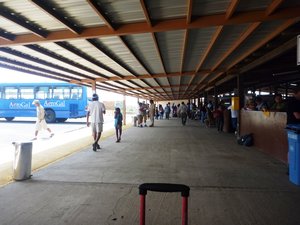Advertisement
Published: March 17th 2010

 Baltra Airport
Baltra Airport
The airport on Baltra Island, waiting to fiond our cruise group.When we first arrived in the Galapagos on Wednesday, the plane landed at the main airport on Isla Baltra, a small island just north of Santa Cruz. It's a convoluted process to get from the airport to the main town of Puerto Ayora: the airline bus takes us all for a 10 minute ride to a ferry, where our bags are loaded on board and we make our way across the channel from Baltra to Isla Santa Cruze. There we got a taxi for the 40 minute drive to Puerto Ayora.
The first day of our Cruise. We were told by our travel agent to meet the cruise group at Baltra airport at 10:30 am on Friday morning. We assumed the cruise boat was going from somewhere on Baltra. To get there from Puerto Ayora back to the airport was the reverse process - taxi, ferry and bus. We had same driver as yesterday, Jose-Luis ("Bull") who looked after us and got our bags on to the ferry and then the bus. He was collecting another fare for the hotel from an incoming flight from Quito. We arrived there at about 10:10, and waited, looking for someone with a sign

 Fish Market
Fish Market
This sealion hangs around the market every afternoon when the fisherman are cleaning and selling their fish. Puts on quite a show! But he also chases away any other sealions that try to muscle in.with the name of our boat, Galaven I. Waiting, waiting...about 10:50 I finally found someone with a name "G5", which turned out to be our boat. It's one of a number of boats owned and run by GAP Adventures (Galaven = Galapagos Adventurer". We had to wait for the next flight for more people for our cruise. They finally came in about 11:30. We then piled onto the airport bus...back to the ferry. Maybe the boat was here somewhere. No, onto the ferry back to Santa Cruz on the other side. Maybe on this side. No, now onto a minibus. Maybe it's taking us to another nearby port. No...back to Puerto Ayora! That's where the cruise starts. We'd left there at 9 am and were back there at 1 pm. We could have been sitting in the town drinking Pina Coladas all morning instead!
But we finally loaded our luggage annd ourselves onto two zodiacs ("pangas") which took us out to our boat. After a quick briefing, we were shown to our cabin. We had the forwardmost, quite a spacious one with a double bed and bunk. Then they served us lunch, and we were back onto the pangas

 Land Iguana CDS
Land Iguana CDS
A captive land iguanan at the Charles Darwin Station (CDS), our first sighting of one.for a short trip to the Charles Darwin Research Station. Here they are breeding giant tortoises for release back into the wild, and doing other research activities to protect the various threatened species. It was interesting to hear of the damage done to Galapagos even as late as the 1950s when goats were released onto Isabela. They ate most of the vegetation, destoying it for the tortoises and all but wiped them out. There are similar stories of other introduced species (dogs, cats, frogs etc) and much work is now being done to firstly eradicate the pests ans then restore the environment back to its origin al condition.
Our arrival on the dock was greeted by a dozen or more marine iguanas - see the pic. They were quite disinterested in us, being used to people as they obviously frequented the dock regularly. Not so the first one we had seen that morning at the ferry dock, which would not let us approach. his was actually unusual we'v e since discovered, all the marine iguanas we've seen in the wild are equally unperturbed. They have no natural predators and visitors are not allowed to touch them, so they do

 Iguanas at CDS
Iguanas at CDS
This was our welcoming commmittee at the CDS dock, all lined up!not develop a natural fear. I guess not so the ones on the ferry dock were there is no control over the tourists.
One of the prize exhibits at the CVharles Darwin Station is Lonesome George. He is the last remaining of his particular species - there are no more. They are trying to breed him with two females of another (but similar) species, to at least retain some of the DNA b ut so far no luck. However, he is quite young at 75 years so they have another century or so of breeding time left.
After the Charles Darwin Station, we were let loose in the town to shop and all that. Naomi and I had already done that so we just killed time at a gallery with some beautiful photos of the wildlife (we'll come backl and buy the book). Then it started to rain quite consistently. Although we are here in the wet season, we have seen no rain until now, and rain at this time of year is generally very light although constant. Apparnetly there was uncharacteristically heavy rain a couple of weeks ago, which has left everything nice and green for us

 Iguana at CDS
Iguana at CDS
This is a marine variety - quite wild, just sitting on the concrete dock soaking up the sun.but made it quite unpleasant for the tour groups the time.
Then we picked up by the pangas to return to the bnoat for dinner and our first night on board.
Advertisement
Tot: 0.083s; Tpl: 0.012s; cc: 10; qc: 50; dbt: 0.0493s; 1; m:domysql w:travelblog (10.17.0.13); sld: 1;
; mem: 1.1mb









